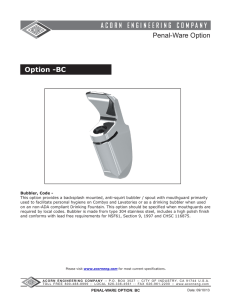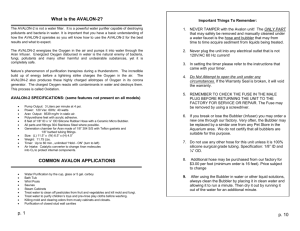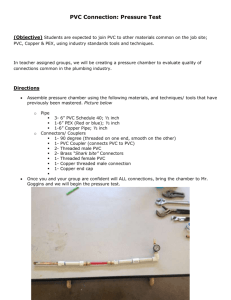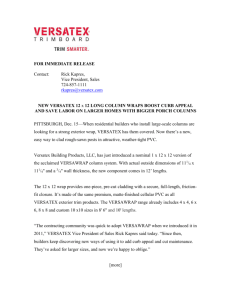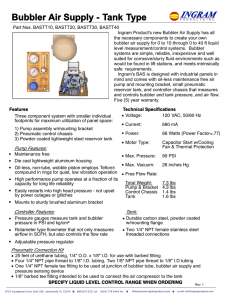Bubbler irrigation installation
advertisement
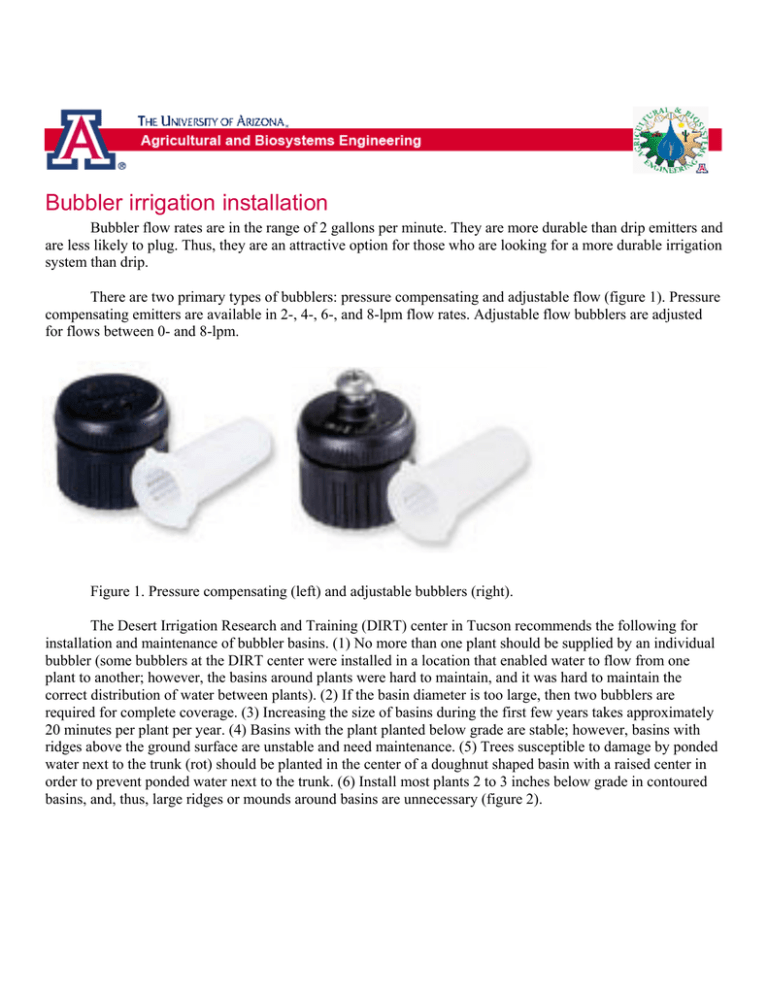
Bubbler irrigation installation Bubbler flow rates are in the range of 2 gallons per minute. They are more durable than drip emitters and are less likely to plug. Thus, they are an attractive option for those who are looking for a more durable irrigation system than drip. There are two primary types of bubblers: pressure compensating and adjustable flow (figure 1). Pressure compensating emitters are available in 2-, 4-, 6-, and 8-lpm flow rates. Adjustable flow bubblers are adjusted for flows between 0- and 8-lpm. Figure 1. Pressure compensating (left) and adjustable bubblers (right). The Desert Irrigation Research and Training (DIRT) center in Tucson recommends the following for installation and maintenance of bubbler basins. (1) No more than one plant should be supplied by an individual bubbler (some bubblers at the DIRT center were installed in a location that enabled water to flow from one plant to another; however, the basins around plants were hard to maintain, and it was hard to maintain the correct distribution of water between plants). (2) If the basin diameter is too large, then two bubblers are required for complete coverage. (3) Increasing the size of basins during the first few years takes approximately 20 minutes per plant per year. (4) Basins with the plant planted below grade are stable; however, basins with ridges above the ground surface are unstable and need maintenance. (5) Trees susceptible to damage by ponded water next to the trunk (rot) should be planted in the center of a doughnut shaped basin with a raised center in order to prevent ponded water next to the trunk. (6) Install most plants 2 to 3 inches below grade in contoured basins, and, thus, large ridges or mounds around basins are unnecessary (figure 2). Figure 2. Contoured basins for bubbler system. One of the problems with installation of sprinklers and bubblers on solid pipe is that people kick and crack the riser pipe or lateral pipe in the ground. Because of the threat of pedestrians at the site kicking the risers, the first bubblers installed at the DIRT center were mounted on rigid Schedule 80 PVC pipe with triple swing joints connecting the pipe to the PVC lateral. This installation was time consuming and adjustment of bubbler height and location was difficult once the pipe was glued into place. The DIRT center developed an easy and inexpensive method of installing bubblers that is both durable and resistant to breakage: flexible PVC connects the bubbler to the lateral pipe. The flexible PVC is a much easier installation than the triple swing joint approach: two quick glue fittings are connected rather than 4 screwed connections on the triple swing joint, and the flexible PVC tube can be extended to any point in the landscape with ease. Flexible PVC tube is resistant to breakage because it bends when struck, and it has a thick wall that resists deformation or puncturing of tube walls. Figure 3 shows the bubbler installation method. First, glue flexible PVC (1/2 inch diameter black tubing from Ag Products) into a 1x1x1/2 TEE. Second, glue a ½ inch (12 mm) male adapter to the flexible PVC. Third, screw the bubbler onto the male adapter. 1/2” Flexible PVC riser 1x1x1/2 Slip Tee Figure 3. Bubbler fittings. 1” PVC Class 200 Pipe 1x1/2 90 It is best to tilt the Tee in lateral sideways (figure 4, right figure). The left side configuration in figure 4 causes the tubing to stick out of the ground and is less attractive. The end of the bubbler should face the shrub so that water sprays away from the plant. In order to facilitate bubbler flow rate measurements, one of the following two methods should be used: 1. Install the flexible PVC with 45 cm (1.5 feet) length above the ground surface. Thus, the bubbler can be inserted into a container such as a milk carton in order to measure volume of flow over a given time. 2. Install the flexible PVC with the bubbler close to grade. A flexible PVC extension with a male adapter and a female adapter can be attached to the installed flexible PVC while it is kinked to temporarily stop water flow. At the DIRT center, bubblers mounted on flexible PVC have been a reliable system. There was some worry about the stability of the glue joints between flexible PVC and rigid PVC, but no glue joints on approximately 100 bubblers have failed in the last 2 years, even in the extreme desert heat. Flexible PVC is thicker than drip tubing and very durable. A rake damaged one bubbler emitter, and three bubblers plugged with rocks. There were no other breakages or plugging. Figure 4. Bubbler orientation of flex PVC pipe.
